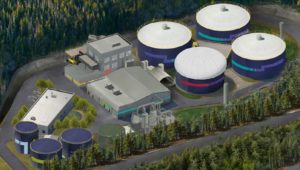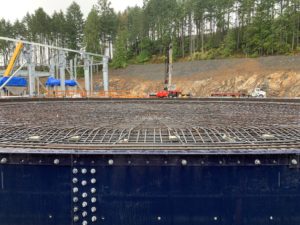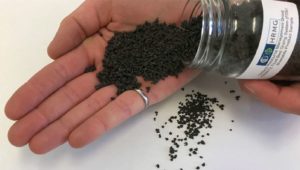A new, state of the art Residuals Treatment Facility by Hartland Resource Management Group is under construction in Saanich.
The Capital Regional District (CRD) is busy with construction of the Wastewater Treatment Project which is making signification progress on its three different components: a wastewater treatment plant (see Winter 2019 issue of the Operator Digest), upgrades to the conveyance system, and a residuals treatment facility.
When municipal sewage is treated, the settled solids captured are termed sludge or residual solids. This sludge has historically been used in agriculture as a nutrient rich fertilizer. In recent times, sludge is treated to eliminate pathogens and vector attractants, and then under strict regulations, can and is still used in agriculture across much of North America and Europe. The BC Organic Matter Recycling Regulations govern the treatment necessary for municipal sewage sludge in BC to produce safe Class B or higher standard, Class A Biosolids that have reduced or eliminated pathogens and can then be beneficially reused in a variety of ways. The Capital Regional District’s new state-of-the-art Residuals Treatment Facility (RTF) that is currently under construction, with a projected completion date of Fall 2020, will produce thermally-dried Class A Biosolids that can be beneficially used.
Unlike the McLoughlin Point Wastewater Treatment Plant that will be operated by the CRD, the Residuals Treatment Facility is being designed, built, operated, and financed by Hartland Resource Management General Partnership (HRMG). Located within the footprint of the Hartland Landfill in Saanich, the facility site was selected in 2013, after an assessment of potential locations that included technical, environmental, social and economic considerations. The Residuals Treatment Facility contract is performance-based, with payment tied to the quantity of residual solids treated.
HRMG is a consortium of Synagro, Maple-Reinders and Bird. Maple-Reinders and Bird, in joint venture, are providing design-build services and Synagro will be providing operator services through Synagro BC Operating Company. Once HRMG has completed design, construction and commissioning of the CRD Residual Treatment Facility, a 20-year service period commences. HRMG will use Synagro BC Operating Company to operate the RTF during this service period.
The CRD’s Residual Solids Conveyance Line will comprise of two pipes connecting the CRD McLoughlin Point Wastewater Treatment Plant to the RTF. The first pipe will be 250mm (10 inches) in diameter and 19.3 km long carrying residual solids from the McLoughlin Point Wastewater Treatment Plant to the RTF. The second pipe will be 300mm (12 inches) in diameter and 12.4 km long carrying the liquid removed from the residual solids from the RTF into the existing sanitary infrastructure that will transport the liquid back to the McLoughlin Point Wastewater Treatment Plant.
Residuals Receiving: In addition to the residuals arriving via pipe, residual solids from other municipal sources as directed by the CRD will be received via truck at the RTF. The facility has been designed to handle both liquid and solid residual deliveries. This in practice means deliveries to the facility by vacuum tanker truck containing residual solids slurry at various solids percentages, or by dump truck as previously dewatered cake at a much higher solids percentage. The two feed streams will be handled at the same unloading point, checked and then pumped to the receiving tanks for mixing with residual solids from the McLoughlin Point Wastewater Treatment Plant.
The CRD is generally obligated to provide residual solids from the McLoughlin Point Wastewater Treatment Plant to the Residuals Treatment Facility with a solids concentration of between 1% and 3%; where 1.5% solids is the design target. HRMG is generally obligated to operate a dryer system that provides thermally dried Class A Biosolids with a minimum solids concentration of 90%; where 92% is the design target.
Gravity Belt Thickeners: The RTF is designed to receive a volume of up to 2M litres per day in 2021, and up to 3.7M litres per day in 2040. The Gravity Belt Thickeners that are designed to increase the concentration of solids prior to digestion will take slurry from ~1.5% solids up to ~6% solids. Water removed from the slurry will be collected in a sump for re-use in the system prior to discharge, and a flocculant will be added to aid in separation. 
Mesophilic Digestion: Three Mesophilic Anerobic Digesters and one Storage/Gas Collection tank are designed for Volatile Solids reduction. The process runs in an anaerobic and mesophilic (kept heated at ~37°C) conditions with controlled agitation. Microorganisms break down volatile solids – essentially eating them and producing gas. To be effective they like a stable pH (near 7) and a consistent temperature. This process is designed to take the slurry from ~6% solids down to ~3% through digestion. The storage/gas collection tank is designed with a flexible membrane roof to accommodate gas production and storage, and the gas will be re-used as fuel for the dryer.
Dewatering: Decanter Centrifuges are designed to operate at high RPMs for efficient water removal and solids concentration. These centrifuges will take the slurry from ~3% solids back up to ~25% solids. Centrifuges run at speeds of up 2600 RPM creating higher than 3000 Gs of force. The water recovered will be sent to the sump for eventual discharge. Flocculant will be added to aid in separation.
Drying: The Fluidized Bed Dryer is designed to utilize the heat generated from burning the digester gas to efficiently remove water from the slurry. The Dryer is designed to take the slurry from ~25% solids up to ~90% solids . The slurry is fed into a hot bed (85C) of already dried product and macerated upon entry to maximize exposed surface area. In addition, large fans blow air up from the bottom into the bed of solids causing the mass to become fluidized. Water is evaporated and then collected through hydro-cyclones and a condenser for re-use as a heat source to maintain digester temperatures prior to discharge. The Fluidized Bed Dryer is a specialty piece of equipment from a leading technology provider based out of Austria. This dryer technology has been incorporated into municipal operations in Europe for more than 15 years and continues to expand throughout North America and Asia. This particular dryer technology was chosen over other dryer technology because of its ability to handle variable feed rates and its efficiency in utilizing digestor produced biogas for thermal energy.
Although BC’s Organic Matter Recycling Regulations would allow for the Class A Biosolids generated from the CRD’s facility to be used for land application, the CRD Board of Directors passed a biosolids land application ban in 2011. In the short term, the CRD intends to transport biosolids from the RTF to cement plants in the BC Lower Mainland where they will be managed through co-combustion to heat cement kilns. However, the CRD has indicated that it is establishing a process for determining a long-term biosolids management strategy. The CRD intends to develop an implementation plan to ensure that biosolids management under a long-term management strategy commences no later than December 2025.
Solids Load Out: The Dried Solids are stored in a silo specially designed for safe/clean loading of trucks. The facility is designed for drive-through access with a top loading retractable chute for effective dust and product management. 
Effluent: All water recovered on-site is collected through the sump network and returned through the effluent tank for discharge back to the Mcloughlin Point Wastewater Treatment Plant. Water is collected from the thickeners, dewatering, and dryer along with plant collection points. Water will be tested to meet acceptance criteria and metered to match desired flows at the Mcloughlin Point Wastewater Treatment Plant.
Odour Control, Propane, and Flare: Ancillary plant processes work to keep the plant safe and minimize impacts to the environment. Odour controls designed to collect potential foul air from the source locations and utilize a scrubber to neutralize prior discharge. Propane acts to provide start-up fuel for the dryer and as a back up heating fuel. The flare is to handle any pressure/volume increases from the digesters’ gas production or as a back-up in the event of dryer upset.
Administration Building: This building will support the RTF staff and provide educational space. It will be equipped with offices and a multi-purpose presentation space, a machine shop for repair work done at site, and a laboratory for bench-top testing and lab analysis.
Synagro is the foremost North American provider of thermally dried Class A biosolids and residuals solutions services since 1986. Headquartered in Baltimore, Maryland, Synagro employs more than 800 people in 34 states and provinces and services more than 600 municipal and industrial water and wastewater facilities. Synagro manages 11 million tons of thermally dried Class A biosolids each year across its facilities. Synagro’s experienced staff provide solutions for all aspects of thermally dried Class A biosolids and residuals management, from land permitting and soil analysis to facilities development.
The RTF is about to undergo pre-classification as a wastewater treatment facility. Concurrently, the EOCP with Synagro is investigating a residuals treatment classification process that may better reflect the complexities of facilities that produce thermally-dried Class A Biosolids for beneficially use.
This project will provide a unique opportunity to see new technology in action in British Columbia, and Canada. Biosolids management will always need to be addressed, and use of new technologies provide valuable options for management.
